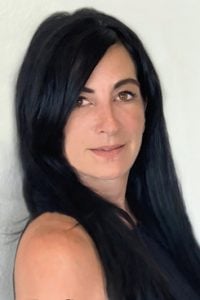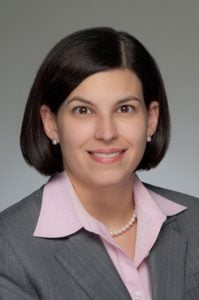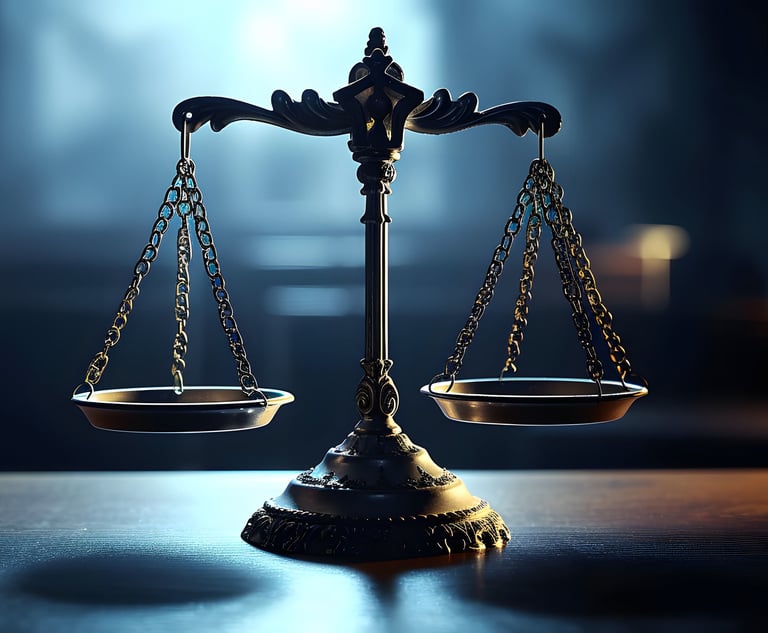The NLJ 500: Climbing Mountains, Cracking Ceilings
The 2019 Women in Law Scorecard has a new firm at No. 1, as others push to recruit and retain women lawyers.
June 25, 2019 at 08:10 AM
8 minute read
 Frieda Garcia, partner with Berry Appleman & Leiden.
Frieda Garcia, partner with Berry Appleman & Leiden.
When Frieda Garcia joined Berry Appleman & Leiden about 18 years ago, the immigration firm was much smaller and had fewer female attorneys. Over the years, as the firm quadrupled its size, it has grown into one of the top destinations for female firm leaders.
This year, the San Francisco-based firm sits atop the The National Law Journal's 2019 Women in Law Scorecard.
Garcia, a senior partner in Berry Appleman's San Francisco office, said seeing female attorneys in leadership roles is one of the biggest changes she's noticed at the firm since she joined: "More women have grown through the ranks and are now in the partnership position, more so than men."
The Women in Law Scorecard rankings are calculated by adding each firm's percentage of total lawyers who are women with the percentage of partners who are women.
 How does your firm compare to peers and competitors? Get the NLJ 500 data exclusively on Legal Compass.
How does your firm compare to peers and competitors? Get the NLJ 500 data exclusively on Legal Compass. At Berry Appleman, which reported having 142 lawyers in 2018 in data submitted to The National Law Journal, 59.2% of them are women. And women accounted for 60% of the total partnership and 57.8% of associates at the firm.
This year, 271 of the nation's 350 largest law firms by head count answered the survey for the Women in Law Scorecard, which ranks the nation's largest law firms by representation of women attorneys. (Berry Appleman was not included in the Scorecard rankings last year because the firm was outside the top 350 of the NLJ 500 based on 2017 lawyer head count.) Among all 271 firms surveyed, women comprised 36.5% of 141,466 attorneys in 2018. But the equity partnership ranks were only 23.5% women, out of 59,000 total partners. Women comprised 47% of the 67,166 associates at all 271 firms.
A Push for Gender Diversity
Firms best known for practices that have traditionally attracted more women lawyers—namely, immigration and labor and employment—remained leaders on the Women's Scorecard. But other firms, particularly some on the Am Law 200, are angling to climb up the list by diversifying lateral searches for partners.
 Avis Caravello, with Avis Caravello Attorney Search Consultants.
Avis Caravello, with Avis Caravello Attorney Search Consultants."Over the last couple of years, and each year more so than the year previous, most of my clients—firms in the Am Law 100, Am Law 200—are very specific when they're conducting lateral partner searches that they want me to focus on finding the female or minority partner candidates," said Avis Caravello, who has run her legal recruiting firm for 30 years.
She added, "awareness of the number of female partners is becoming more of a focus each year for firms," and that is largely a result of client requests.
Tracking the numbers for women at law firms can contribute to meaningful improvement in representation, said Jeremy Fudge, Berry Appleman's Dallas-based managing partner, who has been leading the firm since 2013. "The great thing about competitions and competitors is, if you are approaching it correctly, then it is making you better," he said.
Berry Appleman has been deliberately growing the firm's female and diversity attorney head counts, in part to compete with peers, Fudge said. Part of that stems from changes the firm has made to internal policies to cut down on lawyer attrition more broadly, like allowing for remote work and flexible work schedules.
In addition to the changes aimed at improving diversity, Berry Appleman's primary focus as an immigration law firm helps, as the practice historically tends to attract more women attorneys.
Last year's leader, New York-based immigration boutique Fragomen held a seven-year streak atop the list—and holds the No. 2 spot this year. The firm reported that women made up 65.2% of its 582 lawyers in 2018 and that women accounted for 51% of partners. Additionally, 69.5% of associates at the firm are women.
Regardless of gender, "the immigration area is very conducive to attracting people who want to help others," said Carmita Alonso, a Fragomen partner and executive committee member. "We deal with cultural differences and ethnic differences, different groups, from different countries." After Berry Appleman and Fragomen, four of the next five firms on the Women in Law Scorecard focus on labor and employment law: Kubicki Draper at No. 3; FordHarrison at No. 5; Constangy, Brooks, Smith & Prophete at No. 6; and Littler Mendelson at No. 7.
Progress in Big Law
The majority of the top 30 firms on this year's scorecard have a head count of fewer than 300. Exceptions include San Francisco-based Littler Mendelson (No. 7); Greenville, South Carolina-based Ogletree, Deakins, Nash, Smoak & Stewart (No.14); New York-based Jackson Lewis (No.17); and Los Angeles-based Lewis Brisbois Bisgaard & Smith (No. 25)—all of which have a strong emphasis on labor and employment. These firms also appeared in the top 30 on last year's list.
 Mary Ellen Connerty
Mary Ellen ConnertyIn 2018, a number of other large firms boosted their stats on the Women in Law Scorecard. Those that moved up in the ranks place women in leadership roles and foster a pipeline of female and diverse attorneys.
O'Melveny & Myers landed at 68th on the Women in Law Scorecard this year—up from 104th the previous year. In 2018, women made up 40.3% of O'Melveny's 673 lawyers. Women accounted for 21% of equity partners and 45.5% of associates. From 2017 to 2018, the firm's total female partner head count increased by six.
"Our pipeline of women from counsel to partners has been incredibly strong in the last five years. At least 40% of our partner promotees have been women," said Mary Ellen Connerty, O'Melveny's director of diversity and engagement. "It really speaks to [us having] our eye on these women from a very early stage, up through the years that we bring them to the partnership."
Ropes & Gray, which elected a woman partner as chair for the first time in its more than 150-year history, has moved up to 32nd place on this year's NLJ scorecard, from 36th last year. Julie Jones is set to take over that role when current chair, R. Bradford Malt, retires at the end of 2019.
In 2018, women made up 43.1% of Ropes & Gray's 1,210 lawyers, as well as 26.1% of the equity partners and 45.7% of associates at the firm.
Amanda Morrison, a private equity partner who co-chairs the firm's Women's Forum, said that women attorneys are drawn to Ropes & Gray because they have seen other female leaders succeeding in a variety of practices, and not pigeonholed.
 Amanda Morrison of Ropes & Gray.
Amanda Morrison of Ropes & Gray."What is true then and remains true now is that there were women [who] have built really successful, interesting practices across the whole range of practice areas," said Morrison, who has been with the firm for 20 years. "I felt like there was no limit to what area of law I can choose. I really felt like I had the luxury of finding what felt like the best fit for my interest, my skills, my strength."
Among all 271 law firms surveyed, St. Louis-based Thompson Coburn moved up the most on this year's NLJ scorecard, jumping from 190th place to 75th. In 2018, women made up 33% of the firm's 331 lawyers, 24.1% of equity partners and 42.5% of associates at the firm. Four of the seven attorneys that were promoted to partnership last year were women, according to Thompson Coburn partner Laura Jordan, who also chairs the firm's Women's Initiative.
Asked what makes her firm particularly attractive to the women lawyers, Jordan answered, "critical mass."
"When I started, I looked for other women that I wanted to emulate," Jordan added. "So, being here, and investing, and showing the path of how to practice law in a very vigorous profession—and that it's an achievable goal—is important." Over the last decade, Women's Initiative programming has become much more business-focused at the firm, aimed at involving female attorneys in corporate and strategic developments, she said.
It's "not just about bringing women into the firm, but keeping them here," Jordan said. "And that means we are seeing women who started as associates getting promoted as partners because we have done a better job at keeping them."
This content has been archived. It is available through our partners, LexisNexis® and Bloomberg Law.
To view this content, please continue to their sites.
Not a Lexis Subscriber?
Subscribe Now
Not a Bloomberg Law Subscriber?
Subscribe Now
NOT FOR REPRINT
© 2025 ALM Global, LLC, All Rights Reserved. Request academic re-use from www.copyright.com. All other uses, submit a request to [email protected]. For more information visit Asset & Logo Licensing.
You Might Like
View All
Skadden and Steptoe, Defending Amex GBT, Blasts Biden DOJ's Antitrust Lawsuit Over Merger Proposal
4 minute read
Does the Treasury Hack Underscore a Big Problem for the Private Sector?
6 minute read
Big Law Practice Leaders Gearing Up for State AG Litigation Under Trump
4 minute read
'Religious Discrimination'?: 4th Circuit Revives Challenge to Employer Vaccine Mandate
2 minute readTrending Stories
- 1Decision of the Day: Judge Dismisses Defamation Suit by New York Philharmonic Oboist Accused of Sexual Misconduct
- 2California Court Denies Apple's Motion to Strike Allegations in Gender Bias Class Action
- 3US DOJ Threatens to Prosecute Local Officials Who Don't Aid Immigration Enforcement
- 4Kirkland Is Entering a New Market. Will Its Rates Get a Warm Welcome?
- 5African Law Firm Investigated Over ‘AI-Generated’ Case References
Who Got The Work
J. Brugh Lower of Gibbons has entered an appearance for industrial equipment supplier Devco Corporation in a pending trademark infringement lawsuit. The suit, accusing the defendant of selling knock-off Graco products, was filed Dec. 18 in New Jersey District Court by Rivkin Radler on behalf of Graco Inc. and Graco Minnesota. The case, assigned to U.S. District Judge Zahid N. Quraishi, is 3:24-cv-11294, Graco Inc. et al v. Devco Corporation.
Who Got The Work
Rebecca Maller-Stein and Kent A. Yalowitz of Arnold & Porter Kaye Scholer have entered their appearances for Hanaco Venture Capital and its executives, Lior Prosor and David Frankel, in a pending securities lawsuit. The action, filed on Dec. 24 in New York Southern District Court by Zell, Aron & Co. on behalf of Goldeneye Advisors, accuses the defendants of negligently and fraudulently managing the plaintiff's $1 million investment. The case, assigned to U.S. District Judge Vernon S. Broderick, is 1:24-cv-09918, Goldeneye Advisors, LLC v. Hanaco Venture Capital, Ltd. et al.
Who Got The Work
Attorneys from A&O Shearman has stepped in as defense counsel for Toronto-Dominion Bank and other defendants in a pending securities class action. The suit, filed Dec. 11 in New York Southern District Court by Bleichmar Fonti & Auld, accuses the defendants of concealing the bank's 'pervasive' deficiencies in regards to its compliance with the Bank Secrecy Act and the quality of its anti-money laundering controls. The case, assigned to U.S. District Judge Arun Subramanian, is 1:24-cv-09445, Gonzalez v. The Toronto-Dominion Bank et al.
Who Got The Work
Crown Castle International, a Pennsylvania company providing shared communications infrastructure, has turned to Luke D. Wolf of Gordon Rees Scully Mansukhani to fend off a pending breach-of-contract lawsuit. The court action, filed Nov. 25 in Michigan Eastern District Court by Hooper Hathaway PC on behalf of The Town Residences LLC, accuses Crown Castle of failing to transfer approximately $30,000 in utility payments from T-Mobile in breach of a roof-top lease and assignment agreement. The case, assigned to U.S. District Judge Susan K. Declercq, is 2:24-cv-13131, The Town Residences LLC v. T-Mobile US, Inc. et al.
Who Got The Work
Wilfred P. Coronato and Daniel M. Schwartz of McCarter & English have stepped in as defense counsel to Electrolux Home Products Inc. in a pending product liability lawsuit. The court action, filed Nov. 26 in New York Eastern District Court by Poulos Lopiccolo PC and Nagel Rice LLP on behalf of David Stern, alleges that the defendant's refrigerators’ drawers and shelving repeatedly break and fall apart within months after purchase. The case, assigned to U.S. District Judge Joan M. Azrack, is 2:24-cv-08204, Stern v. Electrolux Home Products, Inc.
Featured Firms
Law Offices of Gary Martin Hays & Associates, P.C.
(470) 294-1674
Law Offices of Mark E. Salomone
(857) 444-6468
Smith & Hassler
(713) 739-1250










